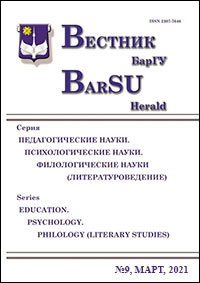ПРОФИЛЬ ЛИЧНОСТИ КРЕАТИВНЫХ СТУДЕНТОВПЕДАГОГИЧЕСКИХ СПЕЦИАЛЬНОСТЕЙ
Ключевые слова:
креативность; креативные качества личности; психологический профиль креативности; личностные черты; студенты педагогических специальностейАннотация
В статье рассматривается дефиниция понятия «креативность». Проведена дифференциация феноменов «креативность» и «творчество». Обоснована востребованность общества в креативных специалистах и в развитии абнотивности будущих специалистов системы образования на этапе обучения в учреждении высшего образования. Приведены результаты эмпирического исследования интегральных креативных качеств студентов педагогических специальностей. Описан их психологический профиль креативности, включающий сознательные, подсознательные и пограничные (сознательно-подсознательные) процессы. Раскрываются эмпирически установленные предикторы составляющих креативности из числа коммуникативных, интеллектуальных, регулятивных личностных свойств будущих специалистов системы образования. Обозначены необходимые векторы развития компонентов креативности и личностных черт креативной личности в высшей
школе. Приведена аргументация отнесения студентов педагогических специальностей, обладающих низким
уровнем интеллектуальных способностей, застенчивых, робких и доверчивых, к группе риска с точки зрения
низкой вероятности реализации креативного потенциала личности.
Рис. 1. Табл. 2. Библиогр.: 5 назв.
Загрузки
Опубликован
Выпуск
Раздел
Лицензия
Copyright (c) 2023 Вестник БарГУ Серия "Педагогические науки. Психологические науки. Филологические науки"
Это произведение доступно по лицензии Creative Commons «Attribution-NonCommercial» («Атрибуция — Некоммерческое использование») 4.0 Всемирная.
Авторы сохраняют за собой право заключать определенные договорные соглашения, касающиеся неисключительного распространения опубликованной версии работы (например, размещать ее в институциональном репозитории, публикация в книге) со ссылкой на ее первоначальную публикацию в этом журнале.





